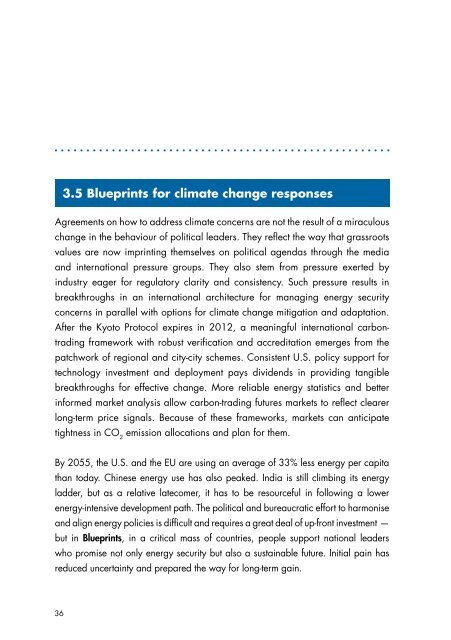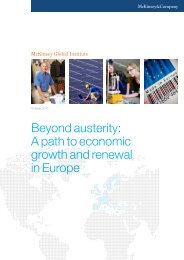Shell energy scenarios to 2050 - Manicore
Shell energy scenarios to 2050 - Manicore
Shell energy scenarios to 2050 - Manicore
Create successful ePaper yourself
Turn your PDF publications into a flip-book with our unique Google optimized e-Paper software.
3.5 Blueprints for climate change responsesAgreements on how <strong>to</strong> address climate concerns are not the result of a miraculouschange in the behaviour of political leaders. They reflect the way that grassrootsvalues are now imprinting themselves on political agendas through the mediaand international pressure groups. They also stem from pressure exerted byindustry eager for regula<strong>to</strong>ry clarity and consistency. Such pressure results inbreakthroughs in an international architecture for managing <strong>energy</strong> securityconcerns in parallel with options for climate change mitigation and adaptation.After the Kyo<strong>to</strong> Pro<strong>to</strong>col expires in 2012, a meaningful international carbontradingframework with robust verification and accreditation emerges from thepatchwork of regional and city-city schemes. Consistent U.S. policy support fortechnology investment and deployment pays dividends in providing tangiblebreakthroughs for effective change. More reliable <strong>energy</strong> statistics and betterinformed market analysis allow carbon-trading futures markets <strong>to</strong> reflect clearerlong-term price signals. Because of these frameworks, markets can anticipatetightness in CO 2emission allocations and plan for them.By 2055, the U.S. and the EU are using an average of 33% less <strong>energy</strong> per capitathan <strong>to</strong>day. Chinese <strong>energy</strong> use has also peaked. India is still climbing its <strong>energy</strong>ladder, but as a relative latecomer, it has <strong>to</strong> be resourceful in following a lower<strong>energy</strong>-intensive development path. The political and bureaucratic effort <strong>to</strong> harmoniseand align <strong>energy</strong> policies is difficult and requires a great deal of up-front investment —but in Blueprints, in a critical mass of countries, people support national leaderswho promise not only <strong>energy</strong> security but also a sustainable future. Initial pain hasreduced uncertainty and prepared the way for long-term gain.36



